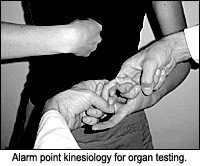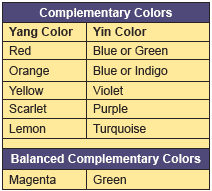By the time most patients decide to visit an acupuncturist or other CAM practitioner, they are past the acute stage of pain or illness. In fact, most patients visiting us have a history of chronic pain and/or illness that has not been well-alleviated with Western medicine.
Microcurrent electroacupuncture therapies usually are highly effective for alleviating pain in muscles, fascia and joints when the proper combination of techniques is used. Such techniques include "circling the dragon" (local point dispersion with biphasic microcurrent), polarized Great Loops holographic treatment,1 local ah-shi point dispersal, and microcurrent interferential pad treatments with active motion. These methods all primarily target the more superficial tendinomuscular meridians, with secondary effects on the principal meridians.
I have found that treatment effectiveness and the carryover of benefits for pain and injury patients can be greatly enhanced when the internal Organs associated with the area of pain also are treated. This article details a very effective treatment method using polarized microcurrent and color light directed through mu (alarm) and shu (associated) acupoints.2 Mu points are on the front of the body; shu points are on the back.
According to Chinese medical theory, front-mu and back-shu points have direct effects on the internal Organs.3 These points often become tender, tight or distended when the associated organs are diseased or imbalanced, and so also can be used diagnostically.
According to our modern understanding of anatomy and physiology, the shu points generally are situated over the autonomic ganglia on either side of the spine. The sympathetic and parasympathetic branches of the autonomic nervous system (ANS) stimulate or relax the functions of most internal organs. Some spinal nerves directly innervate organs, while some connect through nerve chains called ganglia.
The back-shu points associated with each Organ correspond loosely with the ANS innervation of each organ. The chart on page 31 shows these relationships.
As you can see from the chart, the correspondence of spinal nerve innervation to organs described by Western medicine does not always accurately correspond with the relation of back-shu sites in relation to Organs. This is to be expected with two medical systems that evolved independently, and that offer differing descriptions of the organs. Yet there is enough correspondence to link acupuncture stimulation of back-shu points to physical organ effects.
According to all documented systems of color light therapy, the organs are strongly affected by specific colors of light. For each organ, there are one or more colors that stimulate it and one or more colors that inhibit it. These are complementary colors (see chart in next column). Doesn't this sound a lot like the sympathetic-parasympathetic regulation of the organs?
My own research additionally has indicated that the health and balance of Organs is enhanced with polarized microcurrent stimulation. In all cases tested, the positive (+) microcurrent probe needs to be on the front-mu point and the negative (-) probe on the associated back-shu point to promote positive clinical results.
The combination of polarized microcurrent with complementary colors of light has a very powerful and rapid healing and balancing effect on the Organs. Such treatment also supports deeper healing and pain relief carryover for pain and injury treatments.
Here are the steps of treatment:
-
 Use alarm point kinesiology to test each Organ. This is a system developed in Japan in which the patient touches each front-mu (alarm) point while the practitioner tests the strength of the "O" created by the patient's opposite hand by touching the tips of their thumb and middle finger together.4 Using this or other diagnostic methods, determine which Organs are imbalanced. (The "O" ring test will be weak when the patient is touching any mu point associated with an imbalanced Organ.)
Use alarm point kinesiology to test each Organ. This is a system developed in Japan in which the patient touches each front-mu (alarm) point while the practitioner tests the strength of the "O" created by the patient's opposite hand by touching the tips of their thumb and middle finger together.4 Using this or other diagnostic methods, determine which Organs are imbalanced. (The "O" ring test will be weak when the patient is touching any mu point associated with an imbalanced Organ.) - Test which colors make weak mu point tests go back to strong, using therapy localization. To do this, put a color filter on the patient's body in the vicinity of the weak mu point while the patient continues to touch the point, then re-test. Alternatively, apply a second or two of actual color-light stimulation on the point and then re-test. Try various colors until you find the color that makes the test go very strong.
- Select a set of complementary colors that includes the color that made the weak mu point go strong, using the following chart:

For example, you are treating a patient with pain in the right sacroiliac joint and hip area. You find that Liver and Small Intestine mu points were weak on the "O" ring muscle test, and green color tested the strongest to strengthen the weak mu points. In this case, you could use green for local-distal treatment of the painful zones on the SI and hip, and magenta or red for the mu-shu point treatment.
In most cases, use the yin (cooling) color for the local and local-distal microcurrent pain relief techniques, and the yang (supplementing) color for the internal mu-shu treatment. (I do suggest you muscle test to confirm; in some cases these will need to be reversed).

- Using microcurrent and color-light combination treatment (using the yin color), apply 2-3 microcurrent electroacupuncture techniques as listed above. Re-test range of motion of the painful body area to note the degree of improvement after each technique. For most myofascial and joint pain conditions, include microinterferential with simultaneous active motion.
- After the patient has achieved maximum results with these techniques, directly treat the Organ (or two related Organs) with the mu-shu method: select polarized microcurrent, and place the positive probe on the front-mu point of the Organ and the negative trigger probe on the associated back-shu point. Treat both shu points, left and right, in turn. If the mu point also is bilateral, treat the left mu and shu together, then the right mu and shu together. Treat for about 20 seconds per mu-shu set.
In the example above, you could use magenta light with the polarized microcurrent probe, placing the positiveprobe on Liv 14 and the negative probe on UB 18. Treat left, then right. Follow with the positive probe on St 26 or Ren 4 and the negative probe on UB 27, first left, then right.5
This combination of myofascial and internal Organ treatment provides a very thorough way to address the complexity of your patient's presenting conditions.
References
- Details on holographic acupuncture can be found in my article in the Acupuncture Today archives.
- The Acutron Mentor and color light probe combination is used for these examples.
- In this article, the word "Organ" with capital "O" refers to the entities referred to by TCM; the lowercase version refers to the anatomical organs as recognized by Western medicine.
- Details on this practice and the techniques listed above can be found in the author's book, Microcurrent Electro-Acupuncture.
- St 26 is the Japanese mu point for small intestine; Ren 4 is the TCM location.
Click here for previous articles by Darren Starwynn, OMD, LAc.




